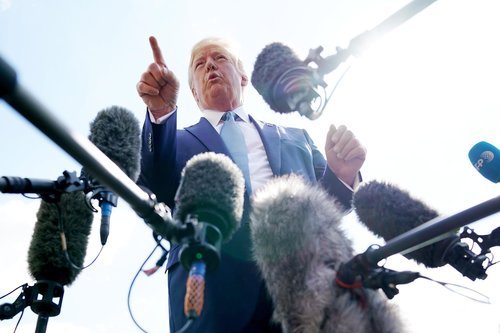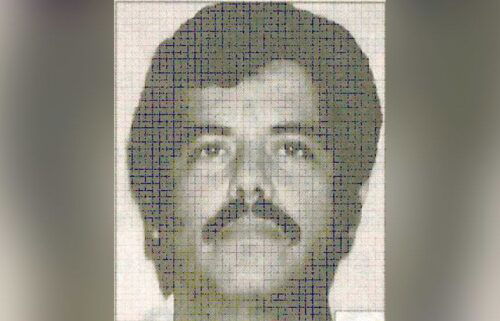Fact check: Trump exaggerates on munitions shortage

We’ve told you about President Donald Trump’s “sir” tell. If Trump recounts a story in which an unnamed person addresses him as “sir,” the story is usually false in some way.
In recent weeks, Trump has been telling a new “sir” story.
“When I took over our military, we didn’t have ammunition,” Trump said Monday. “I was told by a top general — maybe the top of them all — ‘Sir, I’m sorry. Sir, we don’t have ammunition.’ I said, ‘I’ll never let another president have that happen to him or her.’ We didn’t have ammunition.”
As you may have suspected from the two “sir”s or from the substance of the story, Trump’s claim is a severe exaggeration.
While we can’t be sure what a general might have privately told Trump — and though we couldn’t reach former Defense Secretary James Mattis, whom Trump named as the general in a September version of the story — it’s clearly not true that the world’s most powerful military simply “didn’t have ammunition” when he was inaugurated in January 2017.
Lt. Gen. Mark Hertling, a CNN national security analyst who served as commanding general of United States Army Europe before he retired in 2012, called Trump’s account of the general’s supposed comments “ludicrous.”
“No general or admiral would say this,” Hertling said in an email. “They might say they have concerns, or if they were asked to attack a country (say, for instance, North Korea), that a major constraint would be they didn’t have the right amount of ammunition to hit all targets (like, say, all the 10,000 artillery pieces hidden in caves in North Korea, or all the potential rocket sites), but then they would give their requirements.”
As Hertling noted, however, there are some real facts underlying the dubious tale.
What the military has said about munitions levels
According to military leaders, there was a shortfall in certain kinds of munitions, particularly precision-guided bombs, late in the Obama presidency and early in the Trump presidency — after the US used tens of thousands of these munitions in the campaign against ISIS in Iraq and Syria.
Obama administration Defense Secretary Ash Carter said in February 2016: “We’ve recently been hitting ISIL with so many GPS-guided smart bombs and laser-guided rockets that we are starting to run low on the ones that we use against terrorists the most. So we’re investing $1.8 billion in (fiscal year 2017) to buy over 45,000 more of them.”
Adm. Harry Harris, commander of the Navy’s Pacific Command, told Congress in April 2017: “Critical munitions shortfalls are my top warfighting concern … We are short in ‘here-and-now’ basic munitions like small diameter bombs.”
And in a December 2018 speech in which Mattis touted military progress under Trump, he said there had been “munition shortages” two years prior.
Critics of US military intervention abroad might note that one way the US could address a bomb shortage is by doing less bombing. Regardless, Trump wasn’t making the whole thing up: Military leaders did make clear that they thought that the US was lower on certain munitions than it should be, though none of them publicly said anything like “we don’t have ammunition.”
How bad was it?
It has never been clear how dire or how unusual the perceived shortage was, since the military does not release comprehensive data about ammunition levels. Michael O’Hanlon, a Brookings Institution senior fellow who specializes in defense strategy, said “no claims like Trump’s should be taken at face value,” but that we don’t have the information to assess his claims in depth.
“The military generally does have some ‘shortages’ of ammunition, relative to formal goals and preferred levels, at any given time — more often than not,” O’Hanlon said in an email.
Todd Harrison, director of defense budget analysis at the Center for Strategic & International Studies, said that while inventories of some munitions, like Hellfire missiles and Joint Direct Attack Munitions, were “stretched thin” from heavy use in the ISIS conflict and in Afghanistan, the Defense Department “has requested (and received) more money to restock its inventories, and the manufacturers of these weapons have ramped up production to fill these new orders.”
“So while it was a concern, it never became an operational issue as far as I can tell,” Harrison said in an email.
Harrison’s assessment is supported by a 2017 article in which Air Force Col. Randall Ackerman, a spokesman for the Joint Staff, told US News & World Report, “We are currently able to mitigate shortages within combatant commands by managing the redistribution of munitions according to requirements and needs.” A spokesman for the campaign against ISIS also said at the time that the mission “is not affected because of a lack of munitions.”
Lt. Gen. Aundre Piggee, Army deputy chief of staff for logistics, told Congress in March 2017 that while “today I think we have adequate munitions for our normal requirements,” he would be “very concerned with our current stockage of munitions” if “we had to surge, if we had contingency operations and if there continues to be emerging threats we see around the world,” Defense News reported.
Hertling explained that there is “ALWAYS concern” about having insufficient ammunition to fight multiple wars simultaneously; this, he said, is not an issue that will go away.
“The truth of the matter is that there isn’t enough to go around, and when priorities are shifted it would be a logistics challenge to get the right type and right amount of ammo (and other logistics/equipment) to the commander who found himself in a fight,” he said.



